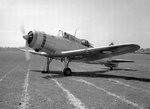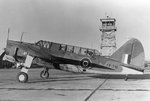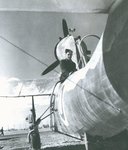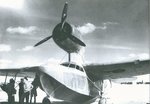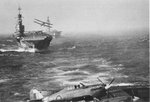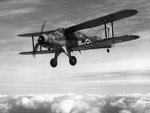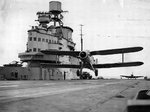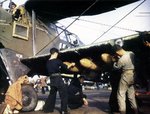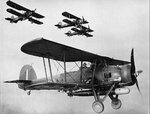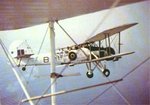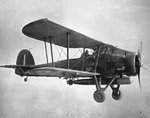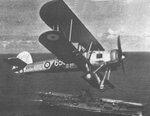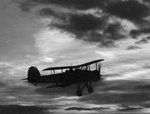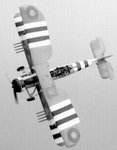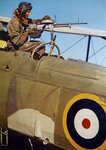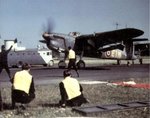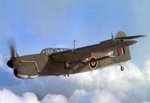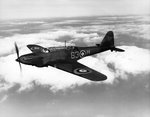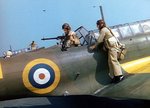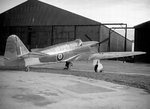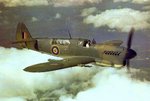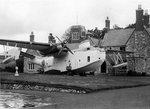Blackburn B-24 Skua
The Skua was the Fleet Air Arm's first fighter/dive-bomber and its first operational monoplane. The Skua was also the first radial-engined all-metal cantilever low-wing monoplane with folding wings, flaps, a retractable landing gear and variable-pitch propeller to be produced in Britain. It was first flown in prototype form on 9 February 1937. The crew of two sat in a glazed cabin, the rear-gunner being armed with one Lewis gun and the pilot with four Browning guns mounted in the wings. One 227kg armour-piercing bomb was carried under the fuselage.
To meet the Royal Navy's ugent requirements 190 Skuas were ordered in July 1936 (six months before the prototype flew) and deliveries were completed in March 1940. Skuas re-equipped Nos 800 and 803 Squadrons on board the aircraft carrier HMS Ark Royal and No 801 on board HMS Furious. A Dornier Do 18 flying-boat - the first enemy aircraft shot down during World War II by the FAA - fell to the guns of a Skua of No 803 Squadron piloted by Lt B. S. McEwen off Heligoland on 25 September 1939. Although quickly replaced as a fighter, it was a very effective dive-bomber, its greatest success being the sinking of the German cruiser Konigsberg in Bergen Harbour on 10 April 1940, which was attacked by seven Skuas of No 800 Squadron led by Capt R. T. Partridge RM and nine Skuas of No 803 Squadron led by Lt W. P. Lucy RN. This involved a long-distance night crossing from Hatston, Orkney. The majority were lost 11 days later when both squadrons embarked on Ark Royal to cover the Narvik operations. In June 1940 No 801 Squadron operated over the Dunkirk beaches from a temporary base at Detling, Kent. After brief operations on board Ark Royal and Argus in the Mediterranean, Skuas were relegated to target-towing in distinctive diagonal black and yellow stripes.
Source: Blackburn B-24 Skua - carrier-borne dive-bomber
The Skua was the Fleet Air Arm's first fighter/dive-bomber and its first operational monoplane. The Skua was also the first radial-engined all-metal cantilever low-wing monoplane with folding wings, flaps, a retractable landing gear and variable-pitch propeller to be produced in Britain. It was first flown in prototype form on 9 February 1937. The crew of two sat in a glazed cabin, the rear-gunner being armed with one Lewis gun and the pilot with four Browning guns mounted in the wings. One 227kg armour-piercing bomb was carried under the fuselage.
To meet the Royal Navy's ugent requirements 190 Skuas were ordered in July 1936 (six months before the prototype flew) and deliveries were completed in March 1940. Skuas re-equipped Nos 800 and 803 Squadrons on board the aircraft carrier HMS Ark Royal and No 801 on board HMS Furious. A Dornier Do 18 flying-boat - the first enemy aircraft shot down during World War II by the FAA - fell to the guns of a Skua of No 803 Squadron piloted by Lt B. S. McEwen off Heligoland on 25 September 1939. Although quickly replaced as a fighter, it was a very effective dive-bomber, its greatest success being the sinking of the German cruiser Konigsberg in Bergen Harbour on 10 April 1940, which was attacked by seven Skuas of No 800 Squadron led by Capt R. T. Partridge RM and nine Skuas of No 803 Squadron led by Lt W. P. Lucy RN. This involved a long-distance night crossing from Hatston, Orkney. The majority were lost 11 days later when both squadrons embarked on Ark Royal to cover the Narvik operations. In June 1940 No 801 Squadron operated over the Dunkirk beaches from a temporary base at Detling, Kent. After brief operations on board Ark Royal and Argus in the Mediterranean, Skuas were relegated to target-towing in distinctive diagonal black and yellow stripes.
Source: Blackburn B-24 Skua - carrier-borne dive-bomber



